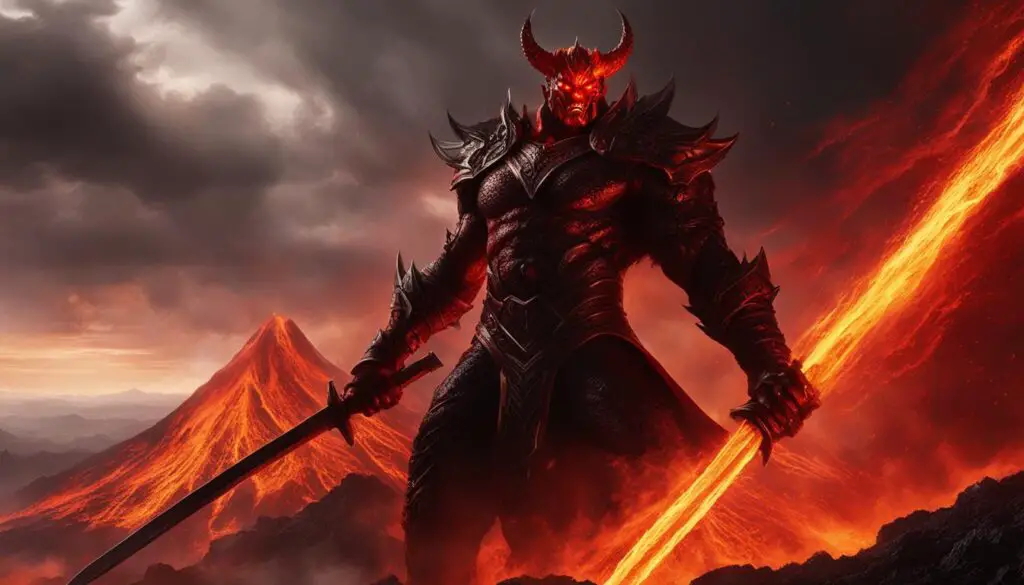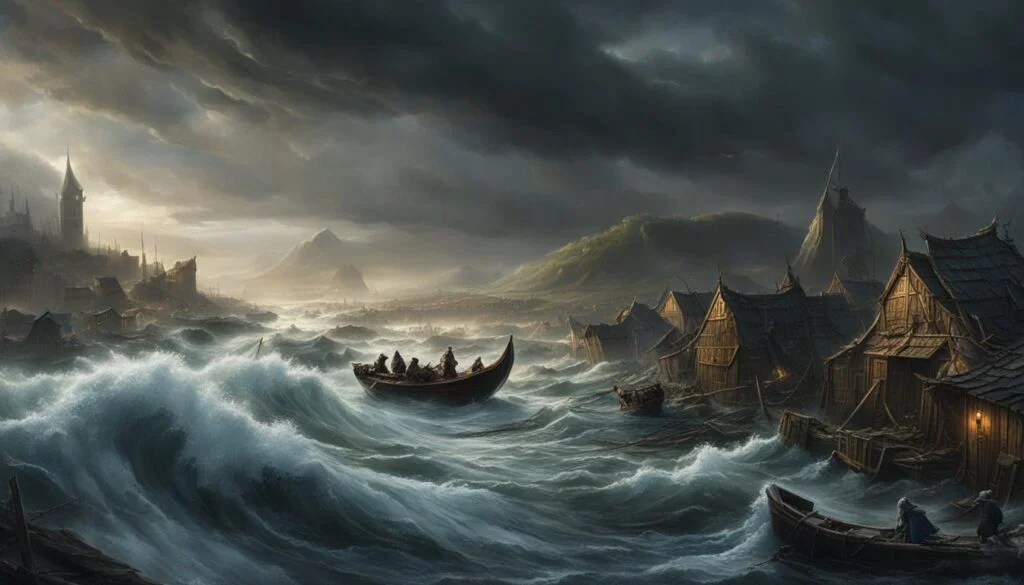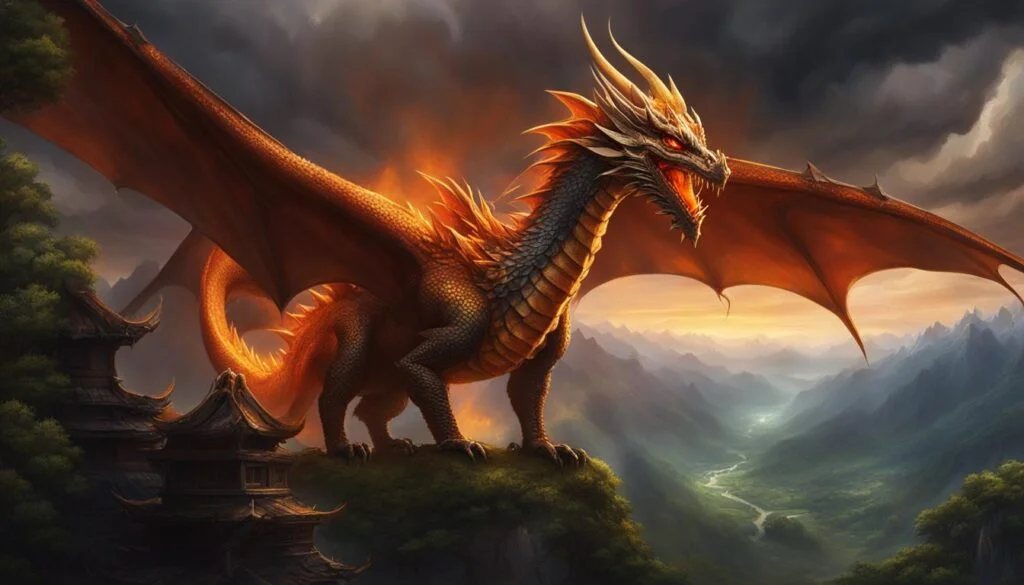Who is Surtur in Norse mythology? Surtur, also known as the fire giant, is an iconic figure in Norse mythology, representing destruction and the end of the world. As a formidable ruler of Muspelheim, the realm of fire, Surtur wields immense power and commands an army of fire giants. His role in the cataclysmic event known as Ragnarok pits him against the Norse gods in an apocalyptic battle that brings about the ultimate demise of the world.
In Norse mythology, Surtur holds a significant place among the mythological figures, like Thor and the gods of Asgard, as well as the interconnected realms of the nine realms. His fiery nature and association with chaos make him a captivating character, explored in various Norse legends and modern interpretations.
Key Takeaways:
- Surtur is a prominent figure in Norse mythology, embodying destruction and the end of the world.
- As the ruler of Muspelheim, the realm of fire, Surtur wields immense power and commands an army of fire giants.
- Ragnarok, the apocalyptic battle, pits Surtur against the Norse gods, leading to the ultimate demise of the world.
- Surtur’s legacy continues to be explored in various Norse legends and modern interpretations of Norse mythology.
- His fiery nature and association with chaos make him a captivating character in Norse mythology.
The Role of Surt in Norse Mythology
Surt, the fiery giant of Muspelheim, plays a significant role in Norse mythology, especially in the epic event known as Ragnarök. Let’s delve into various aspects of Surt’s role, exploring his identity as the ruler of Muspelheim, his association with fire and destruction, as well as his immense power and abilities.
Surt: Ruler of Muspelheim
In Norse mythology, Surt is depicted as the powerful ruler of Muspelheim, the realm of fire. This fiery realm is known for its scorching flames and intense heat, making it an integral part of the Norse cosmology. As the leader of Muspelheim, Surt holds dominion over its forces, embodying the destructive power that threatens the stability of the Nine Realms.
Association with Fire and Destruction
Fire and destruction are inseparable from Surt’s character and role. With his fiery nature, Surt represents the destructive aspect of fire, capable of unleashing chaos and annihilation. His presence symbolizes the imminent cataclysm that engulfs the world during Ragnarök, paving the way for its rebirth and renewal.
Power and Abilities
Surt possesses immense power and formidable abilities befitting his status as a giant. His control over fire is unparalleled, allowing him to unleash devastating flames that consume everything in their path. Additionally, Surt wields a flaming sword, a weapon of immense destructive potential, capable of cutting through even the strongest defenses.
As depicted in various artistic interpretations, Surt’s imposing figure and fierce countenance embody the raw power he possesses. His abilities, combined with his role as the harbinger of destruction, make him a formidable force to be reckoned with in the realm of Norse mythology.
Surtur: The Fiery Giant of Muspelheim
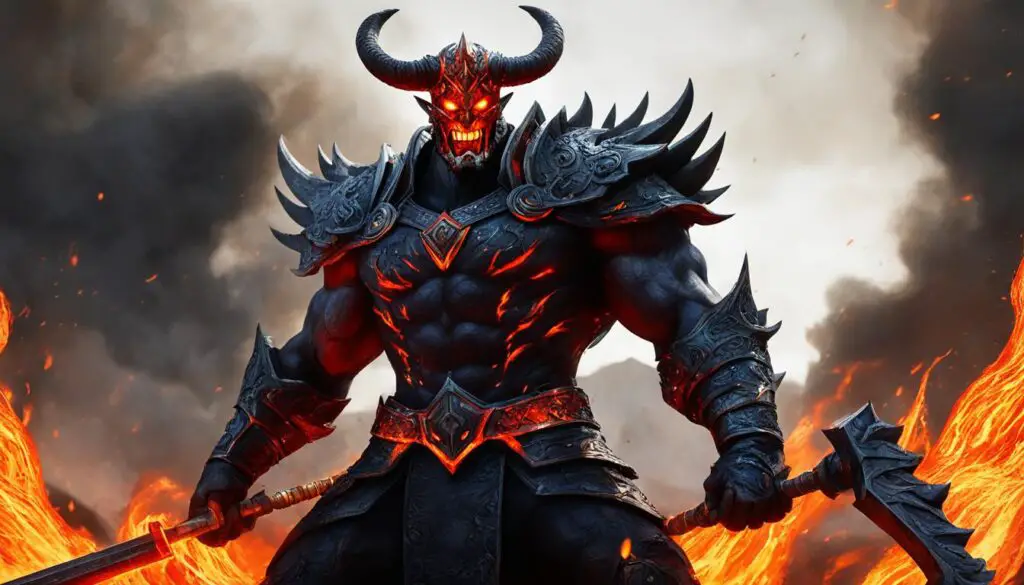
Surtr, also known as Surt, is a formidable figure in Norse mythology, representing the embodiment of fire and ruling over the fiery realm of Muspelheim. As the fire giant, Surtr is a fearsome and influential deity, intrinsically linked to the catastrophic events of Ragnarök.
Surtr’s dominion over Muspelheim, the realm of fire, solidifies his association with flames and destruction. With his imposing presence and control over fire, Surtr wields immense power that instills fear in the hearts of gods and mortals alike.
As the ruler of Muspelheim, Surtr plays a pivotal role in the events of Ragnarök, the apocalyptic battle that marks the end of the world in Norse mythology. With his fiery sword, Surtr leads the army of fire giants into the ultimate clash with the gods, triggering the destruction of the cosmos.
Image:
The fiery image depicted above symbolizes the power and presence of Surtr, the fire giant of Muspelheim. It captures the essence of Surtr’s character and his pivotal role in Norse mythology.
Surtr’s significance extends beyond his association with destruction. As a mythological figure, Surtr represents the cyclical nature of existence, where fire serves both as a purifying force and a harbinger of chaos.
In various modern interpretations, Surtr’s character continues to captivate audiences and serve as a source of inspiration for literature, art, and scholarly studies. His portrayal in popular culture reflects the enduring fascination with Norse mythology and its vivid pantheon of deities.
Discover more about Surtr, the fiery giant of Muspelheim, and delve into the depths of Norse mythology’s cataclysmic events in the upcoming sections of this article.
Surtr’s Association with Fire and Destruction
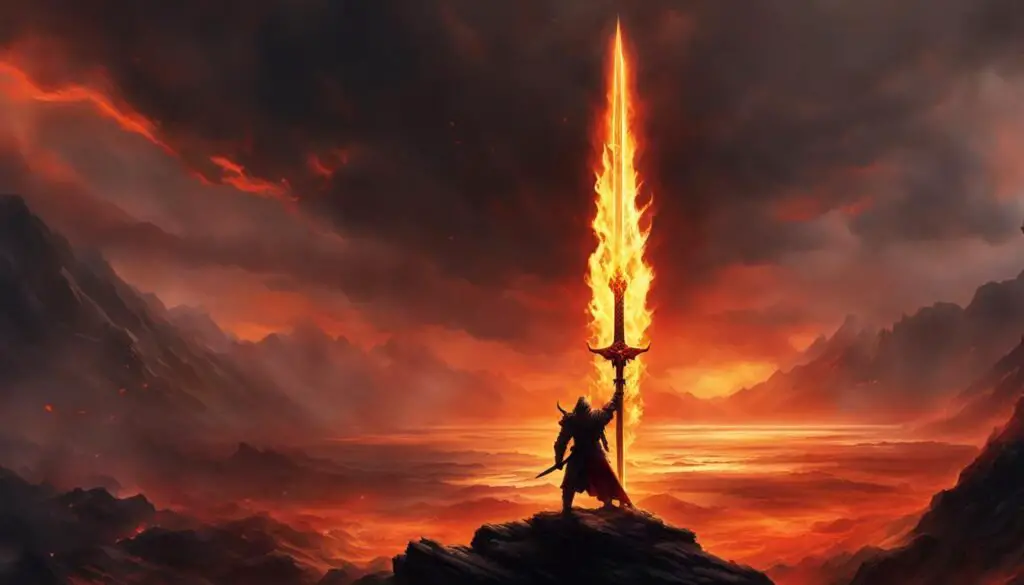
In Norse mythology, Surtr’s association with fire is central to his character and role. He is depicted as the wielder of flames, possessing the ability to summon and control fire at will. This connection to fire is symbolic of his destructive nature and the pivotal role he plays in bringing about the end of the world.
Surtr’s mastery over fire is showcased through his formidable power to unleash devastation upon the realms. With each swing of his flaming sword, he ignites chaos and engulfs everything in his path with blistering flames. This portrayal underscores Surtr’s profound influence as a harbinger of destruction.
The flames that surround Surtr represent not only his physical prowess but also his role as an agent of Ragnarok—the cataclysmic event that marks the end of the world in Norse mythology. As the flames consume the realms, they symbolize the annihilation of old worlds and the opportunity for new beginnings.
Surtr holding his flaming sword, a representation of fire and destruction in Norse mythology.
Surtr’s Immense Power and Abilities
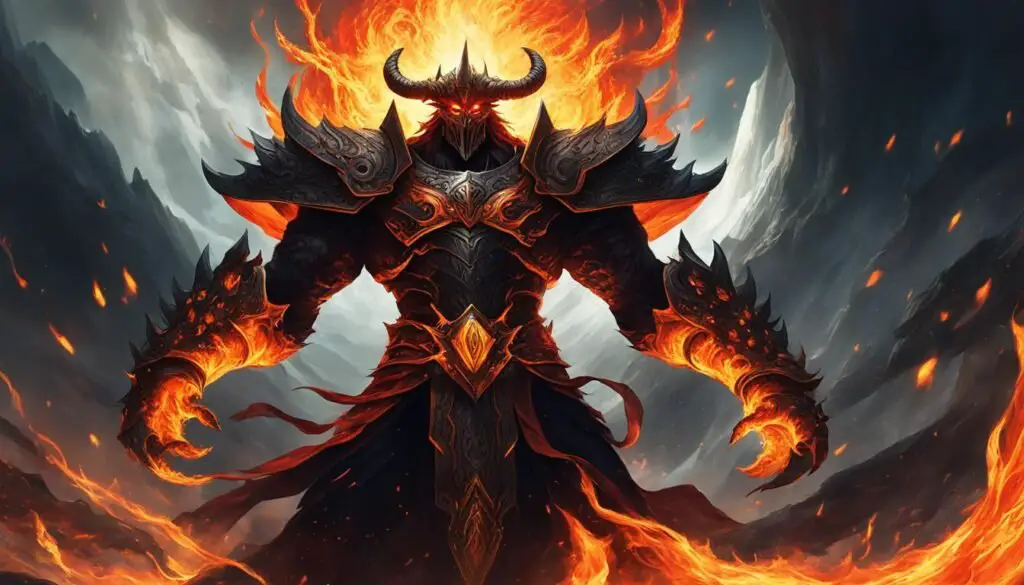
Surtr, the fiery giant of Norse mythology, is known for his immense power and exceptional abilities. As a giant of fire, he possesses unparalleled strength and endurance. With every step, the ground trembles beneath his fiery feet, displaying his sheer physical might. Surtr’s towering presence alone is enough to strike fear into the hearts of even the bravest warriors.
However, it is Surtr’s flaming sword that truly sets him apart. This legendary weapon, often depicted as engulfed in flames, is believed to possess the ability to cut through anything in its path. With a single swing, Surtr can unleash destruction upon his enemies, leaving devastation in his wake. It is this deadly weapon that makes him a formidable opponent in the impending battle of Ragnarök, where the fate of the Norse gods and the world itself hangs in the balance.
Surtr’s command over fire further adds to his intimidating presence. He can summon infernos with a mere thought, manipulating the flames to suit his needs. The fire giant’s control over this primordial force grants him an immense advantage in battle, as he can unleash waves of scorching heat and fiery projectiles upon his adversaries.
Surtr’s abilities extend beyond physical prowess and control over fire. He possesses an uncanny ability to sense and exploit weaknesses, making him an astute strategist on the battlefield. Cunning and ruthless, Surtr utilizes his vast powers to sow chaos and destruction.
In Norse mythology, Surtr embodies the embodiment of destruction and represents the imminent demise of the world. His immense power and unparalleled abilities make him a force to be reckoned with, as he brings forth the cataclysmic events of Ragnarök. As the flames rise and the gods prepare for the final battle, Surtr stands at the forefront, ready to unleash his fiery wrath upon all who dare to oppose him.
Surtr’s Flaming Sword: Symbolism and Significance
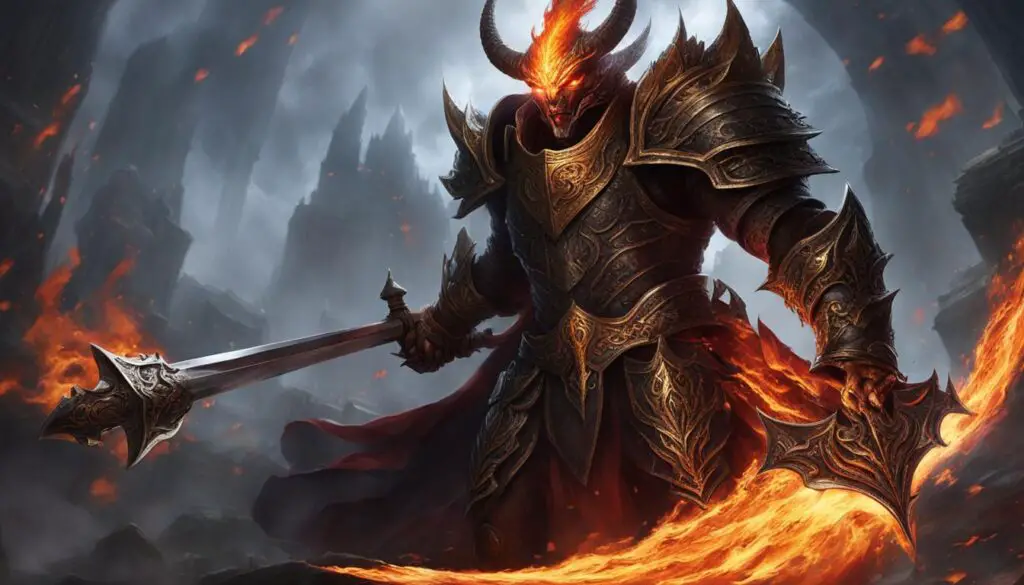
The flaming sword held by Surtr in Norse mythology carries deep symbolism and holds great significance within the context of his character and the events of Ragnarök. This powerful weapon is depicted as a fearsome blade enveloped in flames, representing Surtr’s association with fire and destruction.
The flaming sword symbolizes Surtr’s immense power and serves as a metaphorical extension of his fiery dominion over Muspelheim, the realm of fire. Its flames embody the destructive force that Surtr wields, emphasizing his role as the agent of chaos and catalyst for the end of the world.
Surtr’s flaming sword is not only a physical weapon but also a symbolic representation of his authority and purpose. It signifies the embodiment of fire’s destructive nature and its transformative power. The flames that engulf the sword symbolize the fiery destruction that Surtr brings upon the world during Ragnarök.
Additionally, the flaming sword holds religious and mythological connotations. Fire has long been associated with divinity and sacrificial rituals in various cultures, and its connection to Surtr’s weapon adds a spiritual dimension to its symbolism. The flaming sword signifies not only destruction but also the potential for rebirth and renewal that arises after immense devastation.
The significance of Surtr’s flaming sword extends beyond its physical presence. It represents the irreversible and cataclysmic nature of Ragnarök, highlighting the inevitable destruction that must precede the rebirth of the cosmos. Surtr’s role as the wielder of this fiery weapon solidifies his status as a pivotal figure in Norse mythology, forever etching his name in the annals of mythological lore.
Surtr and Ragnarök: The Final Battle
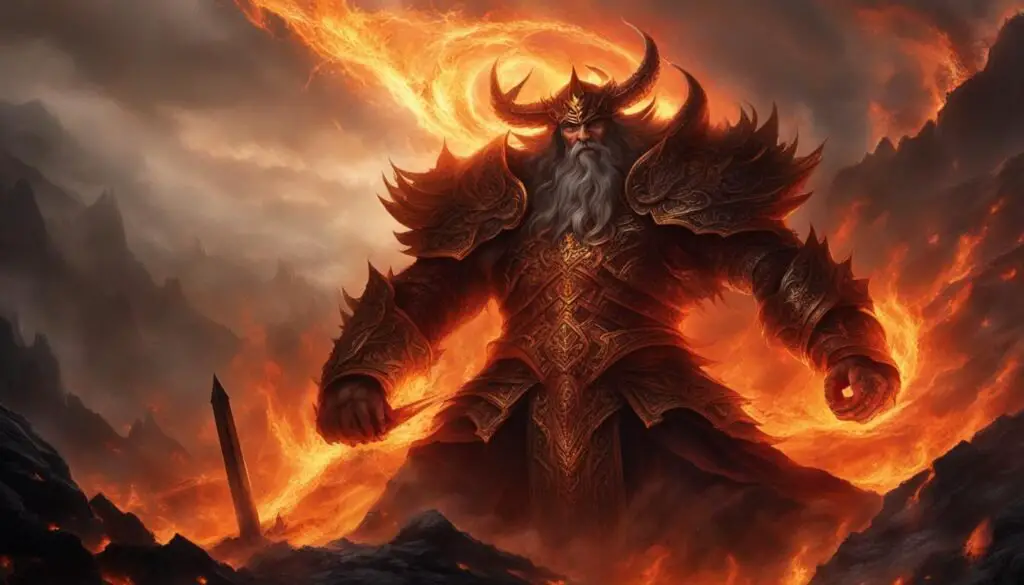
The battle between Surtr and the gods is an epic clash of immense proportions. Surtr, with his formidable strength and powerful flames, stands as a formidable adversary to the gods. His relentless assault tests the gods’ abilities, leading to a devastating confrontation.
The events of Ragnarök escalate as Surtr’s fiery presence engulfs the realms. The forces of chaos are unleashed, resulting in the destruction of the physical and spiritual worlds. Surtr’s flames consume everything in their path, bringing forth a new era of darkness and rebirth. Surtr’s ultimate purpose is to fulfill the prophecy of Ragnarök, where the world is destined to end in flames. As the leader of the fire giants, Surtr spearheads the destruction, heralding the demise of gods, creatures, and realms alike.
Surtr’s Connection to Other Norse Myths and Figures
Surtr, the fiery giant of Norse mythology, is not only known for his role in Ragnarök but also for his intriguing connections to other mythical beings. Surtr’s legacy extends beyond his status as a fearsome giant. In Norse mythology, he is considered to be the father of the fire giants, who serve as his loyal and powerful offspring.
Another significant connection is Surtr’s wife, Sinmara, associated with the earth and the underworld. Sinmara’s influence over the forces of nature and her affinity for the depths of the earth complement Surtr’s dominion over fire, illustrating the interconnectedness of the natural elements within Norse mythology.
Surtr’s daughter, Surtsey, also adds depth to his character. Representing the creative and vitalizing aspects of fire, Surtsey symbolizes the transformative power of flames and their potential for both destruction and renewal. Together, Surtr, Sinmara, and Surtsey represent the complex dynamics of fire and its multifaceted presence in the Norse mythological realm.
Surtr’s immense power as the ruler of Muspelheim and his association with the fiery end of the world make him a figure feared by both gods and beings in Norse mythology. His connections to other Norse myths and figures shed light on the intricate web of relationships and influences within the mythological pantheon, further enhancing the depth and complexity of his character.
Interpretations and Adaptations of Surtr in Modern Culture
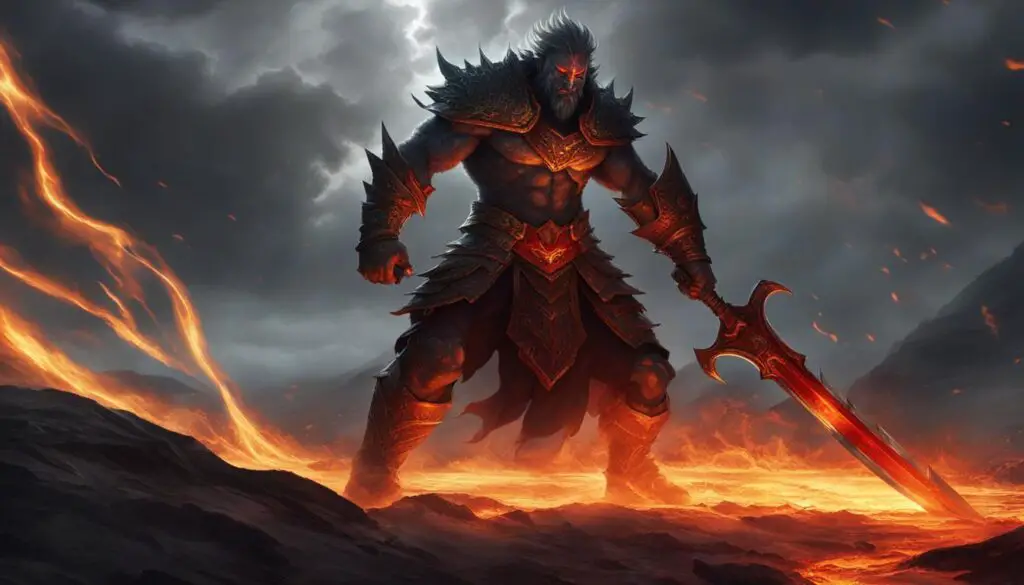
Surtr, the fiery giant of Norse mythology, has captivated the imaginations of authors and artists alike in modern times. His imposing figure and association with destruction make him a compelling character to explore in various works of literature and art.
Surtr’s significance extends beyond literature and art; he also holds a prominent place in contemporary Norse mythology studies. Scholars and enthusiasts continue to analyze and interpret his character, seeking a deeper understanding of his role and symbolism.
Surtr’s story prompts discussions on themes of destruction, rebirth, and the cyclical nature of existence. As an iconic figure, Surtr leaves an indelible mark on modern culture, inspiring creative works and igniting intellectual discourse that explores the deep-rooted myths of Norse tradition.
Artists have reimagined Surtr in various forms, from breathtaking paintings to intricate sculptures, capturing his fiery nature and awe-inspiring presence. Writers have crafted compelling narratives, often exploring Surtr’s motivations and inner conflict as a harbinger of destruction.
In addition to artistic interpretations, Surtr’s character has also found its way into popular literature, comics, and even video games. This portrayal allows audiences to engage with the rich tapestry of Norse mythology and experience Surtr’s formidable persona firsthand.
Modern Surtr Interpretations in Literature
- Surtr as the tortured anti-hero, torn between duty and desire: Writers delve into Surtr’s complex psyche, showcasing his internal struggle and humanizing the fiery giant.
- Surtr as the catalyst for societal change: Authors explore how Surtr’s destructive nature represents the need for transformation and the breaking of old traditions.
- Surtr as a symbol of rebellion: Surtr’s role as a rebellion leader against oppressive forces is a recurring theme in modern literature, highlighting his status as a charismatic figure.
The Artistic Depiction of Surtr in Modern Culture
Within the realm of art, Surtr’s fiery presence takes center stage, evoking a sense of both awe and fear. Artists use various mediums and styles to capture his essence, from vibrant paintings that depict the intensity of flames to intricate sculptures that emphasize his imposing stature.
Surtr’s representation in art often combines elements of traditional Norse aesthetics with contemporary artistic techniques, resulting in visually stunning works that both pay homage to the mythological roots and offer a fresh perspective.
Contemporary Norse Mythology Studies: Exploring Surtr’s Complexity
The enduring interest in Surtr extends to the realm of Norse mythology studies, where scholars and enthusiasts delve deep into his character and significance within the mythological framework. Through extensive research, academic discussions, and critical analysis, Surtr’s role in Norse mythology is continuously explored, offering new insights and interpretations.
These studies shed light on Surtr’s symbolic meaning and unearth the philosophical themes intertwined with his fiery nature. The cyclical nature of destruction and rebirth, as represented by Surtr, becomes a focal point of analysis, inviting scholars to ponder the deeper meanings of existence and the inevitable cycles that shape our world.
Surtr’s legacy in Norse mythology studies remains vital, as new discoveries and perspectives emerge, allowing for a more comprehensive understanding of this captivating figure and his significance in the broader Norse mythological tradition.
The Viking Perspective: Fire and Ragnarok
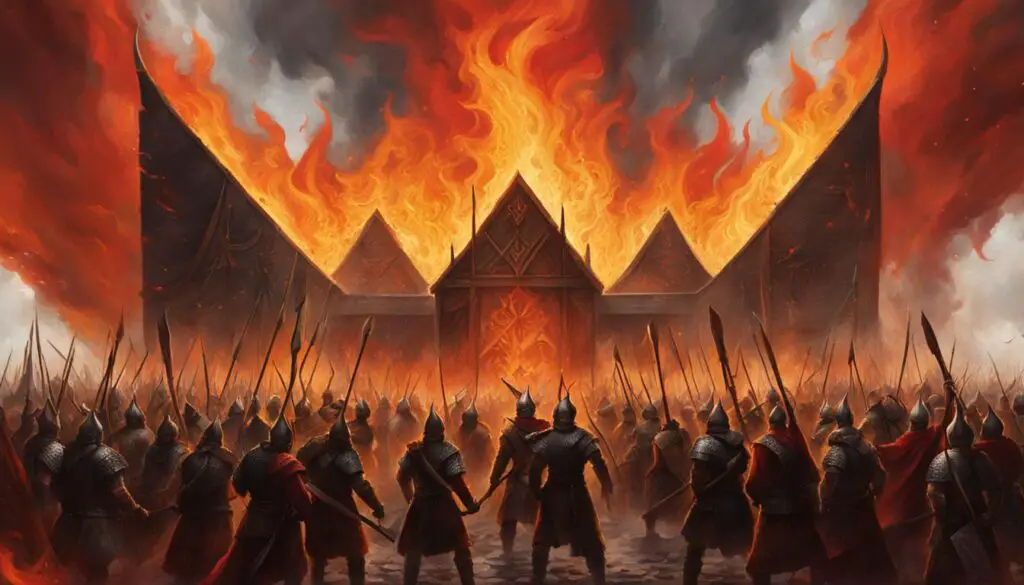
The Vikings, living in a harsh and unpredictable pre-modern society, held fire in high regard due to its association with destruction and renewal. Fire worship and rituals played a crucial role in Viking culture, where fire was seen as both a force of creation and destruction. The Vikings revered and feared fire gods such as Surtr and Loki, as they embodied the power and unpredictability of fire. One of the myths that the Vikings believed in was Ragnarok, the mythological event marking the end of the world. Fire played a central role in Ragnarok, symbolizing the cycle of destruction and rebirth that was intrinsic to Norse mythology.
Symbolism and Rituals:
In Viking culture, fire held deep symbolism. It represented not only destruction but also renewal and transformation. Through fire worship and rituals, the Vikings sought to harness the power of fire to bring about positive changes in their lives. Fire was used in sacred ceremonies, symbolizing purification and the initiation of new beginnings.
- Fire was regarded as a sacred element, connecting mortals to the divine.
- Ritualistic bonfires were lit to honor the gods and ensure their favor.
- Fire was used in funeral pyres, a practice believed to release the deceased’s spirit into the afterlife.
- Fire festivals, such as the traditional Viking celebration of Yule, were held to ward off the darkness of winter and welcome the return of the sun.
The Fire Gods:
Surtr and Loki, two prominent fire gods in Norse mythology, held significant influence over the Vikings and their beliefs regarding fire.
- Surtr: As the ruler of Muspelheim, Surtr represented the destructive nature of fire. He was seen as the harbinger of Ragnarok, leading the forces of chaos and destruction in the final battle against the gods.
- Loki: Although not solely associated with fire, Loki, the trickster god, had a close connection to it. His mischievous nature often led to destructive outcomes, and his association with fire symbolized his unpredictable and chaotic influence.
The Vikings’ interpretation of fire and its connection to Ragnarok reflected their worldview, where destruction and rebirth were fundamental aspects of existence. Fire, as a symbol of transformation, played a central role in their culture and religious practices.
Conclusion
In Norse mythology, Surtur, the fiery giant and ruler of Muspelheim, holds a pivotal role as the embodiment of destruction and the end of the world. His association with fire and immense power make him a formidable adversary in the cataclysmic battle of Ragnarok. This captivating mythological figure continues to inspire modern interpretations, from literature to art and scholarly studies. Surtur’s story highlights the intricate interplay between destruction, rebirth, and the enduring themes of human existence.
The legend of Surtur has left an indelible mark on Norse culture and beliefs. As the god of fire and chaos, he symbolizes the cataclysmic events of Ragnarok, where the world meets its fiery end. Surtur’s role as a mythological figure showcases the fascination of ancient civilizations with powerful elemental forces and their impact on human destinies. Through Surtur, we glimpse into the profound human exploration of life’s cyclical nature, the inevitability of destruction, and the potential for rebirth.
The legacy of Surtur extends beyond the pages of ancient texts, fueling the imagination of artists, writers, and scholars alike. His reign over Muspelheim and his fiery sword continue to captivate audiences, ensuring that his story remains a prominent motif in Norse mythology. Surtur’s tale invites us to delve into the complexities of human existence, the forces of nature, and the eternal struggle between creation and destruction. His presence reminds us of the enduring power of mythological figures in shaping our understanding of ourselves and the world we inhabit.
FAQ
Who is Surtur in Norse mythology?
Surtur is a fiery giant and a significant figure in Norse mythology. He is the ruler of Muspelheim, the realm of fire, and embodies destruction and the end of the world.
What is the role of Surt in Norse mythology?
Surt, as the ruler of Muspelheim, holds the role of a fire giant associated with fire and destruction. He possesses immense power and abilities.
What is the significance of Surtur in Norse mythology?
Surtur, also known as Surtr, is a fiery giant from Muspelheim who plays a crucial role in the cataclysmic event of Ragnarök, the end of the world.
How is Surtur associated with fire and destruction?
Surtur’s association with fire and destruction is central to his character in Norse mythology. He is the wielder of flames and represents the destructive force the world faces during Ragnarök.
What are Surtur’s immense power and abilities?
As a fire giant, Surtur possesses unparalleled strength and endurance. His flaming sword, feared by all, is believed to have the ability to cut through anything.
What is the symbolism and significance of Surtur’s flaming sword?
Surtur’s flaming sword symbolizes his association with fire and destruction. It represents his immense power and serves as a metaphorical extension of his fiery dominion over Muspelheim.
How does Surtur’s story tie into the final battle of Ragnarök?
Surtur, as the leader of the fire giants, plays a pivotal role in the final battle of Ragnarök. He leads his army against the gods, ultimately resulting in the destruction of the world.
What other Norse myths and figures are connected to Surtur?
Surtur is considered the father of the fire giants, and his wife, Sinmara, is associated with the earth and the underworld. His daughter, Surtsey, represents the creative aspects of fire.
How is Surtur interpreted in modern culture?
Surtur’s captivating character continues to inspire literature, art, and scholarly studies. Modern interpretations explore his role and symbolism, prompting discussions on destruction, rebirth, and the cyclical nature of existence.
What was the Vikings’ perspective on fire and Ragnarok?
Fire held significant cultural and religious symbolism for the Vikings. Fire worship and rituals played a crucial role, and fire gods like Surtr were revered and feared for their association with destruction and the events of Ragnarok.
How does Surtur fit into Norse mythology?
Surtur, as a powerful fire giant and central figure in Ragnarök, embodies the mythological aspects of Norse legends, particularly in relation to the end of the world and the role of mythological figures like Thor and Asgard.


